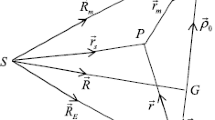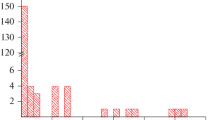Abstract
The Cassini spacecraft collects high resolution images of the Saturnian satellites and reveals the surface of these new worlds. Tiscareno et al. succeeded to determine the Epimetheus rotation from the Cassini Imaging Science Subsystem data, initiating studies on the rotation of Epimetheus and its companion Janus (Tiscareno et al., Icarus 204:254–261, 2009; Noyelles, Icarus 207:887–902, 2010; Robutel et al., Icarus 211:758–769, 2011). Especially, Epimetheus is characterized by its horseshoe shape orbit and the presence of the swap has to be introduced explicitly into rotational models. During its journey in the Saturnian system, Cassini spacecraft accumulates the observational data of the other satellites and it will be possible to determine the rotational parameters of several of them. To prepare these future observations, we built rotational models of the coorbital (also called Trojan) satellites Telesto, Calypso, Helene, and Polydeuces, in addition to Janus and Epimetheus. Indeed, Telesto and Calypso orbit around the L 4 and L 5 Lagrange points of Saturn-Tethys while Helene and Polydeuces are coorbital of Dione. The goal of this study is to understand how the departure from the Keplerian motion induced by the perturbations of the coorbital body, influences the rotation of these satellites. To this aim, we introduce explicitly the perturbation in the rotational equations by using the formalism developed by Érdi (Celest Mech 15:367–383, 1977) to represent the coorbital motions, and so we describe the rotational motion of the coorbitals, Janus and Epimetheus included, in compact form.
Similar content being viewed by others
References
Arnold V.I., Kozlov V., Neistadt A.: Mathematical Aspects of Classical and Celestial Mechanics. Encyclopaedia of Mathematical Sciences. Springer, Berlin (2006)
Celletti A., Chierchia L.: Measures of basins of attraction in spin-orbit dynamics. Celest. Mech. Dyn. Astron. 101, 159–170 (2008)
Christou A.A., Namouni F., Moreira Morais M.H.: The long term stability of coorbital moons of the satellites of Saturn. I. Conservative case. Icarus 192, 106–116 (2007)
Érdi B.: An asymptotic solution for the trojan case of the plane elliptic restricted problem of three bodies. Celest. Mech. 15, 367–383 (1977)
Érdi B.: The three-dimensional motion of trojan asteroids. Celest. Mech. 18, 141–161 (1978)
Giorgini, J.D., Yeomans, D.K., Chamberlin, A.B., Chodas, P.W., Jacobson, R.A., Keesey, M.S., et al.: JPL’s on-line Solar system data service. In: Bulletin of the American Astronomical Society, volume 28 of Bulletin of the American Astronomical Society, p. 1158 (1996)
Henrard J., Lemaitre A.: A second fundamental model for resonance. Celest. Mech. 30, 197–218 (1983)
Jacobson R.A., Spitale J., Porco C.C., Beurle K., Cooper N.J., Evans M.W., Murray C.D.: Revised orbits of Saturn’s small inner satellites. Astron. J. 135, 261–263 (2008)
Jorba A., Simó C.: On quasiperiodic perturbations of elliptic equilibrium points. SIAM J. Math. Anal. 27(6), 1704–1737 (1996)
Kevorkian, J.: The planar motion of a Trojan asteroid. In: Giacaglia, G.E.O. (Ed.) Periodic Orbits Stability and Resonances, pp. 286–303. Reidel (1970)
Landau L., Lifchitz E.: Mechanics. Pergamon press, Oxford (1960)
Laskar J.: The chaotic motion of the Solar system. A numerical estimate of the size of the chaotic zone. Icarus 88, 266–291 (1990)
Laskar J.: Introduction to frequency map analysis. In: Simó, C. (ed.) Hamiltonian Systems with Three or More Degrees of Freedom, NATO ASI, pp. 134–150. Kluwer, Dordrecht (1999)
Lichtenberg A.J., Lieberman M.A.: Regular and Chaotic Dynamics, Vol 38 of Applied Mathematical Sciences. Springer, Berlin (1992)
Morais M.H.M.: Hamiltonian formulation of the secular theory for Trojan-type motion. Astron. Astrophys. 369, 677–689 (2001)
Murray C.D., Dermott S.F.: Solar System Dynamics. Cambrige University press, Cambridge (1999)
NASA, Jet Propulsion Laboratory, Space Institute: Cassini image N00172886. http://saturn.jpl.nasa.gov/photos/raw/rawimagedetails/index.cfm?imageID=239054 (2011)
Noyelles B.: Theory of the rotation of Janus and Epimetheus. Icarus 207, 887–902 (2010)
Peale S.J.: Origin and evolution of the natural satellites. Annu. Rev. Astron. Astrophys. 37, 533 (1999)
Porco C.C., Thomas P.C., Weiss J.W., Richardson D.C.: Saturn’s small inner satellites: clues to their origins. Science 318, 1602–1607 (2007)
Robutel P., Rambaux N., Castillo-Rogez J.: Analytical description of physical librations of Saturnian coorbital satellites Janus and Epimetheus. Icarus 211, 758–769 (2011)
Salo H., Yoder C.F.: The dynamics of coorbital satellite systems. Astron. Astrophys. 205, 309–327 (1988)
Sharma R.K., Rao P.V.S.: Stationary solutions and their characteristic exponents in the restricted three-body problem when the more massive primary is an oblate spheroid. Celest. Mech. 13, 137–149 (1976)
Thomas P.C.: Sizes, shapes, and derived properties of the saturnian satellites after the Cassini nominal mission. Icarus 208, 395–401 (2010)
Thomas P.C., Davies M.E., Colvin T.R., Oberst J., Schuster P., Neukum G., Carr M.H., McEwen A., Schubert G., Belton M.J.S.: The shape of Io from Galileo Limb measurements. Icarus 135, 175–180 (1998)
Thomas P.C., Burns J.A., Helfenstein P., Squyres S., Veverka J., Porco C., Turtle E.P., McEwen A., Denk T., Giese B., Roatsch T., Johnson T.V., Jacobson R.A.: Shapes of the saturnian icy satellites and their significance. Icarus 190, 573–584 (2007)
Tiscareno M.S., Thomas P.C., Burns J.A.: The rotation of Janus and Epimetheus. Icarus 204, 254–261 (2009)
Vienne A., Duriez L.: TASS1.6: Ephemerides of the major Saturnian satellites. Astron. Astrophys. 297, 588–605 (1995)
Wisdom J.: Rotational dynamics of irregularly shaped natural satellites. Astron. J. 94, 1350–1360 (1987)
Wisdom J.: Spin-orbit secondary resonance dynamics of enceladus. Astron. J. 128, 484–491 (2004)
Author information
Authors and Affiliations
Corresponding author
Rights and permissions
About this article
Cite this article
Robutel, P., Rambaux, N. & El Moutamid, M. Influence of the coorbital resonance on the rotation of the Trojan satellites of Saturn. Celest Mech Dyn Astr 113, 1–22 (2012). https://doi.org/10.1007/s10569-012-9406-2
Received:
Revised:
Accepted:
Published:
Issue Date:
DOI: https://doi.org/10.1007/s10569-012-9406-2




